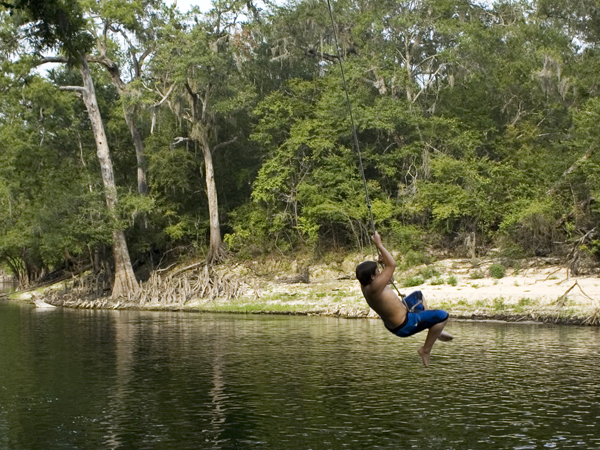Research finding: Over-the-water rope tree swings fraught with danger

Published in News Stories on August 01, 2016
Years ago on a canoe trip in Missouri, University of Mississippi Medical Center pediatrician Dr. Will Sorey took in the beauty of a spring-fed river - marred, however, by some things that can be pretty ugly when it comes to your health.
“As we went, I noticed about every quarter mile that there were rope swings hanging in various stages of disrepair,” said Sorey, professor of pediatrics. “I asked the outfitter on the trip about them, and he said, 'Those are not our swings, and we've had more injuries on them than anything else.'”
That canoe trip was Sorey's impetus for more than a decade of the study of river tree rope swings and their dangers. He canoes or kayaks rivers and streams at least twice monthly, mostly in central and south Mississippi, but also has collected data in other states. “It's what's known as having an avocation within your vocation,” said Sorey, who wrote a journal article based on his research. “There's very little that has been written about river swings, and it piqued my interest.”
There's also very little education on the propensity for river tree rope swing injuries. The most common: broken fingers or burns that happen when someone grips or loses their grip on a swinging rope, especially when they grasp thin lengths of rope that are tied to the end of a thicker section.
The worst: paralysis or death from drowning, usually either from the person being injured in the course of their fall or being entrapped under water by brush or trees.
Use of rope swings can be extreme, such as a 2013 incident in which a Utah 22-year-old was killed trying to swing through the opening of a 110-foot-tall sandstone arch in the mountains near Salt Lake City. The man was trying to imitate a stunt he saw on a video that had gone viral on YouTube.

Sorey explains how someone using a river tree rope swing can get their ankles, hands or fingers entangled in a thin cord that's often tied to the end of a larger piece of rope.
A snapshot of 2011-2015 statistics for Mississippi compiled by the National Electronic Injury Surveillance System (NEISS) chronicles rope tree swing injuries that include facial abrasions, contusions to buttocks, lacerations and multiple contusions to limbs and heads, limb and tailbone fractures, head and back injuries, concussions, first- and second-degree rope burns, dislocated hips and shoulders, perforated and popped eardrums, snake bites, abdominal wall and vaginal contusions, testicular contusions, and near-drownings.
The most common reasons those 78 Mississippians ages 5-25 were injured or nearly drowned include landing on ground instead of in water, catching fingers or limbs in rope while falling, ropes wrapping around limbs, jumping or diving into shallow water, landing on tree stumps or branches in water, releasing a rope too soon, or simply landing hard or belly-flopping on water. Several victims landed partially in water and partially on land.
One 18-year-old female apparently didn't learn from her first fall, the data show. On the same day in July 2012, she jumped out of a tree and landed on her buttocks in a lake, then swung from a rope-suspended tire swing and landed on her back. She injured both her sacrum and coccyx at the base of her spine.
NEISS is under the umbrella of the federal Consumer Products Safety Commission, which collects data on a plethora of injuries stemming from a multitude of causes.
A possible collision with a swimmer by someone using a rope tree swing was cited in the recent death of a Simpson County teen whose body was found early the morning of June 30. Authorities believe he drowned in a swimming hole about 15 feet deep at the D'Lo Water Park in Simpson County. Rope tree swings aren't allowed at the popular water park.

Jones
Injuries from rope tree swings are hard to track because there's not a good medical diagnostic code for them, said Dr. Alan Jones, professor and chairman of the Department of Emergency Medicine.
“The most dangerous thing is related to head or spinal injuries from not knowing the depth of the water, or debris that might be underwater,” Jones said. “People go headfirst into shallow areas, and they can hit their head and have a cervical spine injury or a traumatic head injury. The dreaded thing with a cervical spine injury is complete paralysis.”
It's not hard to locate - or simply happen upon - a rope tree swing on Mississippi rivers and other bodies of water. A “swimming holes info” website lists a number of water parks in the state along with 21 swimming holes, and the site includes information on which have rope tree swings.
You'll find a lot of them south of I-20, most of them hung by people who frequent the rivers, said Calvin Fulton, director of training and boating law administrator with the state Department of Wildlife, Fisheries and Parks “They just see it as a good place for a swing,” Fulton said.
“When they a see rope swing, people say, 'Wow, that looks so fun!' And their thinking stops there,” Sorey said. “There's no respect. They're having fun.”
More injuries stemming from river tree rope swings occur than are officially reported, Fulton said. His department generally becomes aware of incidents only if they result in a death by drowning, he said.

Sorey has photographed many rope swings, including this one in south Mississippi.
Sorey collects data on the location and types of rope swings and what injuries have resulted from their use. His research also has included performing laboratory studies on samples of rope to assess entanglement risk. “Every time I'd go somewhere, I'd take photos, measure the water, and ask the outfitters if they'd had injuries,” Sorey said. “To a person, they'd say yes. I'd go to small towns in Appalachia and visit their newspapers and ask about it.”
The newspaper accounts he fielded from across the country included a case in which a 27-year-old man performed a “failed backward somersault” that left him a paraplegic. In another, a teen died when he lost his grip on a rope swing and fell 60 feet from a river bluff.
“We've had broken necks in Mississippi,” Sorey said. “Lawsuits over these things are huge in some venues. Quadriplegia was the big thing in my studies.”
Sorey compiled his data to produce “River Tree Rope Swing Injuries,” an article published in 2008 in the Southern Medical Journal. Sorey is first author on the study. Co-authors are one of his UMMC colleagues, professor of pediatrics Dr. Jeffrey Crout; former UMMC faculty member Dr. Philip Blount, a physician at Methodist Pain & Spine in Flowood, a division of Methodist Rehabilitation Center; and Dr. Laura Cassidy, director of the Division of Epidemiology in the Medical College of Wisconsin's Institute for Health and Society.
Sorey also has produced a slide presentation on river tree rope swing injuries. “How shall I hurt me? Let me count the ways,” one slide says atop a drawing of a tree branch hanging over a river.
Complicating rope swing dangers is the fact that most injuries occur in remote areas. “Getting EMS out there can take a lot more doing, unless the canoe outfitters have a very good communications system,” Sorey said. “Inevitably, you can't get a vehicle there. Often, cell phones just don't work. If someone is badly injured, you have a real mess on your hands.”
Sorey and Jones draw the same conclusion about river tree rope swings: They're dangerous.
But for those who are going to do it, “you need to know that you can physically perform the task,” Jones said. “Some people might jump off a platform and think they can hold up their weight, but their grip on the rope isn't strong enough.
Know the strength of the rope, Sorey said. Some cloth or vinyl rope and thin cord “is never designed to hold a human's weight,” he said. “People tie the cord on the end of a bigger rope to fish the rope back to the tree. When they swing out and get tangled in the cord, then that takes fingers off.”
“You need to know what's under the water and what the depth of the water is,” Jones said. “And, you wouldn't want to mix alcohol with any type recreational activity like that because it increases the risk of injury.”
Photos
 | High Resolution Medium Resolution Low Resolution |
 | 1f Darlenia,Amy.Dr.Mrs.Wallace.jpg High Resolution Medium Resolution Low Resolution |
 | 2a Jay Lindsay.jpg High Resolution Medium Resolution Low Resolution |


